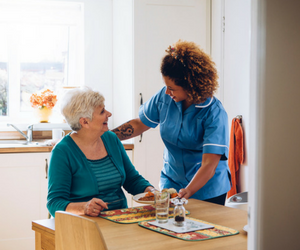Going gluten free as a senior
While learning to live a gluten-free lifestyle can be daunting to anyone, it provides unique challenges to seniors over age 65.

As awareness of gluten issues grow, more and more people – including seniors – are being diagnosed with celiac disease and gluten allergies. While learning to live a gluten-free lifestyle can be daunting to anyone, it provides unique challenges to seniors over age 65.
Here, we address some challenges seniors going gluten-free may grapple with.
 Getting diagnosed with a gluten sensitivity
Getting diagnosed with a gluten sensitivity
Once considered a disease that affects mainly children, doctors now know that gluten issues can affect anyone at any age. But for older people who may be grappling with other health issues, getting a proper diagnosis can be tricky because the symptoms mimic those of a number of other ailments.
To get a proper diagnosis, you’ll want to first rule out celiac disease, an auto-immune disorder caused by gluten that attacks the small intestines. Celiac affects 1 percent of Americans, says Lola O’Rourke, the education supervisor at The Gluten Intolerance Group of North America. That translates to about 400,000 adults over age 60.
A celiac screening test is a simple blood test and the key to this test is to get screened before you take gluten out of your diet, says O’Rourke. Otherwise, “you’re going to have a potential false negative.”
If you don’t have celiac, the next step is to test yourself for “non-celiac gluten sensitivity,” which affects about 18 million Americans, or six times the number of those who have celiac, according to the Beyond Celiac website.
“There isn’t a test for non-celiac gluten sensitivity. The only way to know if you have it is to give up gluten for several weeks and then binge on it. If you feel really bad, then you probably have it,” says Jane Anderson, a medical journalist who writes about the gluten-free lifestyle for Verywell.com and who has been gluten-free since 2003.
The good news is most gluten issues can be managed with diet alone, and the growing awareness of the gluten-free lifestyle means living gluten-free has never been easier.
Dining out
Many restaurants these days have gluten-free options labeled on their menus, making dining out for gluten-free seniors much easier.

Here are some tips:
- Call ahead to find out if a restaurant has a gluten-free menu or gluten-free options
- Inform your waiter that you are gluten-free, not by choice, but because of serious health reasons
- Speak to the chef and ask for menu accommodations or recommendations
“The beauty is now if you say, ‘I’m gluten-free,’ you don’t get a blank stare, you get, ‘oh yeah, my mother or my aunt is gluten-free,’” says Anderson, who has written many articles for Verywell on dining out.
Gluten-free eating at home

Dining at home is always a gluten-free person’s best option. You don’t have to worry about cross-contamination on a cutting board or someone adding a dash of flour as a sauce thickener.
But while there are a ton of gluten-free labeled processed foods (no need to give up beer, bread, crackers or even cereal), seniors should consider sticking to the basics, such as: dairy, fresh fruits, meats and veggies.
Why? Because for seniors, “your caloric needs go down, but your need for nutrients goes up,” says O’Rourke, who is also a registered dietician. Processed foods, even the gluten-free ones, can be unhealthy.
What’s more, there’s no reason a gluten-free lifestyle should be limiting.
“We encourage people to really explore ethnic cuisines. There’s a whole world of Asian, Indian and Mexican cuisines that don’t rely on gluten-filled ingredients at all,” says O’Rourke.
To learn more about gluten-free food options, see “What Can I Eat” from the Celiac Disease Foundation.
Grocery shopping
Anyone on a gluten-free diet needs to become an expert label reader because many foods contain gluten, especially processed ones.
“The biggest issue is learning where to look for gluten. You can’t just say, ‘I’m going to give up bread and cookies.’ It’s nowhere near the only gluten in everything,” says O’Rourke.
Here are some tips to follow when reading labels, according to Celiac.org:
- Check for obvious glutens: barley, brewer’s yeast, malt, oats, rye, soy, wheat.
- “Wheat-free” does not necessarily mean “gluten-free.” When in doubt, go without.
- You can generally trust the “gluten-free” label because the FDA regulates gluten in food.
Prescription medications, supplements and vitamins with gluten 
Seniors with a gluten intolerance need to be careful managing over-the-counter and prescription meds, many of which contain gluten in their
binding agents.
Both Anderson and O’Rourke recommend seniors make friends with their pharmacist. The pharmacist can check if your meds contain gluten and help find an alternative for those that do. Because binders can change in a prescription, you should have the pharmacist check every prescription with every refill.
Anderson also adds that “it’s easy to do supplements because a lot of them are gluten-free and the companies want you to know it,” says Anderson, who orders her own supplements on Amazon and finds that many companies label their products “gluten-free.”
She does caution, however, that “it’s unusual, but not unheard of, to find a supplement that has gluten.”
Learn more at Celiac.org and Glutenfreedrugs.com, a searchable prescription and over-the-counter database that is managed by a pharmacist.
Searching for gluten-free senior living

One of the biggest problems gluten-free seniors face is finding an assisted living or long-term care community that can accommodate their specific dietary needs.
Communities that provide long-term care must provide a diet prescribed by a doctor, but assisted living and retirement facilities do not, Ronni Alicea, a dietician specializing in gluten-free diets in healthcare facilities, said to the Gluten-Free & More website.
Still, more and more residences are adopting gluten-free menu options. Grandview Terrace in Sun City West, Arizona, and GenCare Lifestyle communities in Arizona and Washington are all gluten-free certified.
Not all seniors can afford or want to move far away to a community that specialize in their needs. So how to find a place that can work with you? You can start by researching residences and setting up appointments.
“You have to talk to the people in charge of the food – the dining coordinator or dietitian or the staff on consult,” says Anderson, who recommends that you “don’t just ask, ‘can you do gluten-free.’” Instead, ask them to walk you through a week’s worth of menus.
Also ask to speak to other gluten-free residents who can tell you straight out if the food is good, if the community really sticks to a GF menu and if there is variety and a lot of options so you won’t get bored.
This article originally appeared on aplaceformom.com.
Author: Julyne Derrick
https://goo.gl/rMG84n
DISCLAIMER–The views and opinions expressed here are based solely on personal experience, research and my interactions other professionals in the field of health and wellness. This article is not a diagnose, or medically based advise. Your experiences and sentiments may differ from my own. If you are suffering from any serious medical condition, you should consult your doctor or naturopath for a diagnosis.


 jttphotography.com/ james takakura
jttphotography.com/ james takakura